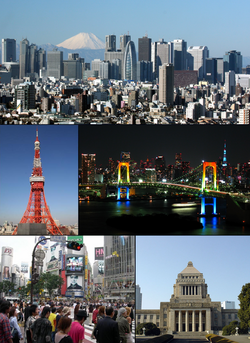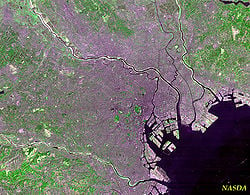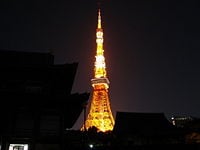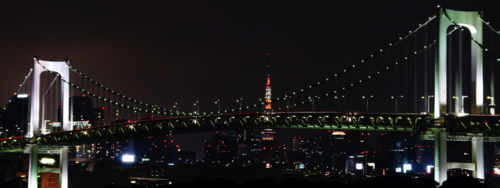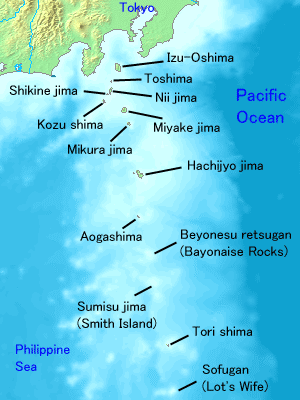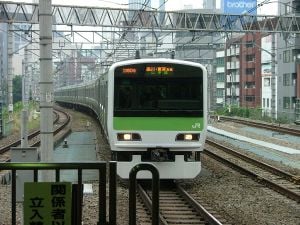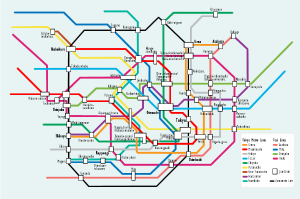Tokyo
| Tokyo 東京 |
|||
| — Metropolis — | |||
| 東京都 · Tokyo Metropolis | |||
| From top left: Nishi-Shinjuku, Tokyo Tower, Rainbow Bridge, Shibuya, National Diet Building | |||
|
|||
| Location of Tokyo in Japan | |||
| Satellite photo of Tokyo's 23 Special wards taken by NASA's Landsat 7 | |||
| Country | Japan | ||
|---|---|---|---|
| Region | Kantō | ||
| Island | Honshu | ||
| Divisions | 23 special wards, 26 cities, 1 district, & 4 subprefectures | ||
| Government | |||
| - Type | Metropolis | ||
| - Governor | Shintaro Ishihara | ||
| - Capital | Shinjuku | ||
| Area (ranked 45th) | |||
| - Metropolis | 2,187.66 km² (844.7 sq mi) | ||
| - Metro | 13,572 km² (5,240.2 sq mi) | ||
| Population (August 1, 2011)[1] | |||
| - Metropolis | 13,185,502 | ||
| - Density | 6,027.2/km² (15,610.4/sq mi) | ||
| - Metro | 35,682,460 | ||
| - Metro Density | 2,629/km² (6,809.1/sq mi) | ||
| - 23 Wards | 8,967,665 | ||
| (2011 per Prefectural Government) | |||
| Time zone | Japan Standard Time (UTC+9) | ||
| ISO 3166-2 | JP-13 | ||
| Website: www.metro.tokyo.jp | |||
Tokyo (東京 Tōkyō), the common English name for the Tokyo Metropolis (東京都 Tōkyō-to), is the most populous prefecture and city in Japan, and the center of the Greater Tokyo Area which is the most populous metropolitan area in the world with a population of over 37 million people. The Tokyo Major Metropolitan Area includes the cities of Chiba, Kawasaki, Sagamihara, Saitama, and Yokohama, making it the world's most populous metropolitan area. The twenty-three special wards of Tokyo, although each administratively a city in its own right, constitute the area informally considered as the "city of Tokyo" and are collectively one of the largest cities in the world with a total population of over 9 million people.[2] It is one of the 47 prefectures of Japan and, unique among the prefectures, provides certain municipal services characteristic of a city.
Edo (the old name for Tokyo) rose to prominence when Tokugawa Ieyasu made it his political base in 1590. By the eighteenth century it had become one of the largest cities in the world, with a population of over one million. In 1869, the seventeen-year-old Emperor Meiji moved to Edo, which had been renamed "Tokyo" ("Eastern Capital") the year before. Because it is the seat of the Japanese government and the Imperial Palace, and the home of the Japanese Imperial Family, Tokyo is the de facto capital of Japan. Tokyo is considered one of the world's major global cities and a megacity. It has the largest metropolitan gross domestic product in the world for a city, and it held the title of the world's most expensive city for over a decade from 1992 through 2005.[3]
Name
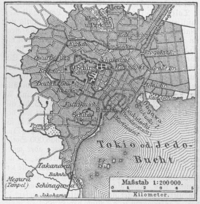
When Edo Castle was constructed in 1457; the city was known as Edo (江戸). In September of 1868, when the shogunate came to an end, Emperor Meiji ordered Edo to be renamed "Tokyo," meaning "Eastern Capital" Tokyo (東京 Tōkyō). The new name was meant to emphasize Tokyo's status as the new capital of Japan, both temporally and spiritually.
During the early Meiji period, the city was also called "Tōkei," an alternative pronunciation for the same Chinese characters representing "Tokyo." Some surviving official English documents use the spelling "Tokei." This pronunciation is now obsolete. An older method of romanizing Japanese also resulted in "Tokio" as an earlier spelling.
The name "Tokyo" refers variously to Tokyo Metropolis (the prefecture) as a whole, or only to the main urban mass under its jurisdiction (thus excluding west Tama and Izu / Ogasawara Islands), or even the whole of Greater Tokyo Area, which includes Tokyo, Kanagawa, Saitama, Chiba, Gunma, Tochigi, Ibaraki, and Yamanashi prefectures, depending on context.
History
The site of Tokyo has been inhabited since ancient times; the small fishing village of Edo existed there for centuries. In the seventh century, the mainland area now occupied by Tokyo was, together with modern-day Saitama Prefecture and the cities of Kawasaki and the eastern part of Yokohama, established as Musashi, one of the provinces under the ritsuryō system. Small parts of modern Tokyo were in Shimosa Province. The central part of the twenty-three special wards lay in Toshima, Ebara, Adachi, and (in Shimosa) Katsushika Districts. Western Tokyo occupied Tama District. Tokyo's oldest Buddhist temple, Sensō-ji in Asakusa, is said to date from the year 645.
In 1457, Ōta Dōkan built Edo Castle on the site. Hōjō Ujitsuna entered Edo Castle in 1524, and Tokugawa Ieyasu moved there in 1590. Tokyo's rise to importance can be largely attributed to Tokugawa Ieyasu and Emperor Meiji. Tokugawa Ieyasu made Edo his political base. When he became shogun in 1603, the town began to grow as the capital of his nationwide military government. By the eighteenth century it had become one of the largest cities in the world, with a population of over one million. It became the de facto capital of Japan, even while the emperor lived in Kyoto, the imperial capital.
After 263 years, the shogunate was overthrown and Japan was returned to imperial rule by the Meiji Restoration. In 1869, the seventeen-year-old Emperor Meiji moved to Edo, which had been renamed "Tokyo" ("Eastern Capital") the year before. Tokyo was already the nation's political, economic, and cultural center; moving the emperor's residence to the former Edo Castle, now the Imperial Palace, made it the de facto imperial capital. The city of Tokyo was established, and continued to serve as the capital until it was abolished as a municipality in 1943 and merged with the "Metropolitan Prefecture" of Tokyo.
Since about the turn of the century (1900), Central Tokyo, like Osaka, has been designed around major train stations in high-density areas, so that suburban railways were built relatively cheaply at street level. Though expressways have been built, the basic design has not changed to this day.
Tokyo suffered two major catastrophes during the twentieth century, but recovered from both. In 1923 the Great Kantō earthquake struck Tokyo. A massive reconstruction plan was drawn up, but was too expensive to complete. The World War II fire bombings of Tokyo in 1945 killed 75,000 to 200,000 people and destroyed half of the city.[4] After the war, Tokyo was completely rebuilt, and showcased to the world during the city's 1964 Summer Olympics. The 1970s brought new high-rise developments such as Sunshine 60, a new and controversial airport at Narita and a population increase to about 11 million in the metropolitan area.
Tokyo's subway and commuter rail network became the busiest in the world as more and more people moved to the area. In the 1980s, real estate prices skyrocketed during an economic bubble. The bubble burst in the early 1990s and many companies, banks, and individuals were caught when the value of their real estate holdings suddenly shrank. A major recession followed, making the 1990s Japan's "lost decade," from which it is now slowly recovering.
Recent urban development projects include Ebisu Garden Place, Tennozu Isle, Shiodome, Roppongi Hills, Shinagawa (now also a Shinkansen station), and Tokyo Station (Marunouchi side). Buildings of significance are frequently demolished to create space for more up-to-date shopping facilities such as Omotesando Hills. Land reclamation projects in Tokyo have also been going on for centuries. The most prominent is the Odaiba area, now a major shopping and entertainment center.
Tokyo was hit by powerful earthquakes in 1703, 1782, 1812, 1855 and 1923. The 1923 earthquake, with an estimated magnitude of 8.3 on the Richter Scale, killed 142,000 people.
Various plans have been proposed for transferring national government functions from Tokyo to secondary capitals in other regions of Japan, in order to slow down rapid development in Tokyo and revitalize areas of the country which are lagging economically. These plans have aroused considerable controversy within Japan and have yet to be realized.
Geography and Administrative Divisions
The mainland portion of Tokyo lies northwest of Tokyo Bay and measures about 90 km east to west and 25 km north to south. It borders Chiba Prefecture to the east, Yamanashi Prefecture to the west, Kanagawa Prefecture to the south, and Saitama Prefecture to the north. Mainland Tokyo is further subdivided into the special wards (occupying the eastern half) and the Tama area (多摩地方) stretching westwards.
Also within the administrative boundaries of Tokyo Metropolis are two island chains directly to the south in the Pacific Ocean: the Izu Islands, which are almost parallel to the Izu Peninsula; and the Ogasawara Islands, which stretch more than 1,000 km away from mainland Japan.
Under Japanese law, Tokyo is designated as a to (都, often translated "metropolis"). Its administrative structure is similar to that of Japan's other prefectures. Within Tokyo lie dozens of smaller entities, most of them conventionally referred to as cities. It includes twenty-three special wards (特別, 区, -ku) which until 1943 comprised the city of Tokyo but are now separate, self-governing municipalities, each with a mayor and a council, and having the status of a city. In addition to these 23 municipalities, Tokyo also encompasses 26 more cities (市, -shi), five towns (町, -chō or machi), and eight villages (村 -son or -mura), each of which has a local government. The Tokyo Metropolitan Government is headed by a publicly elected governor and metropolitan assembly. Its headquarters are in the ward of Shinjuku. They govern all of Tokyo, including lakes, rivers, dams, farms, remote islands, and national parks in addition to its famous neon jungle, skyscrapers and crowded subways.
The 23 special wards
The special wards (tokubetsu-ku) of Tokyo comprise the area formerly known as Tokyo City, usually simply known as "Tokyo." On July 1, 1943, Tokyo City was merged with Tokyo Prefecture (東京府, tokyo-fu) forming the current "metropolitan prefecture." As a result of this merger, unlike other city wards in Japan, these wards are not part of any city.
Each ward is a local municipality with its own elected mayor and assembly, differing from an ordinary city in that certain governmental functions are handled by the Tokyo Metropolitan Government, and, for most, also differing in having no particular center and little cultural or similar distinctiveness from the immediate surroundings.
The term "central Tokyo" today may refer to the twenty-three special wards, the centers of Shinjuku, Minato, Chiyoda and Chūō connected and enclosed by the Yamanote Line, or to the three centrally located wards of Chiyoda, Chūō and Minato. While the generally accepted center of Tokyo is the Imperial Palace, as a railway-oriented city, Tokyo contains a number of major urban centers where business, shopping, and entertainment are concentrated around major train stations. These include:
- Akasaka
- A district with a range of restaurants, clubs and hotels; many pedestrian alleys give it a local neighborhood feel. Next to Roppongi, Nagatachō, and Aoyama.
- Akihabara
- A densely arranged shopping district for electronic, computer, anime, and otaku goods.
- Aoyama
- A neighborhood of Tokyo with parks, an enormous cemetery, expensive housing, trendy cafes and international restaurants. Includes the Omotesandō subway station.
- Ginza and Yūrakuchō
- Major shopping and entertainment district with department stores, upscale shops selling brand-name goods, and movie theaters.
- Ikebukuro
- The busiest interchange in north central Tokyo, featuring Sunshine City and various shopping destinations.
- Marunouchi and Ōtemachi
- The main financial and business district of Tokyo has many headquarters of banks, trading companies and other major corporations. The area is seeing a major redevelopment with new buildings for shopping and entertainment constructed in front of Tokyo Station's Marunouchi side.
- Nagatachō
- The political heart of Tokyo and the nation. It is the location of the Diet, government ministries, and party headquarters.
- Odaiba
- A large, reclaimed, waterfront area that has become one of Tokyo's most popular shopping and entertainment districts.
- Roppongi
- Home to the rich Roppongi Hills area, an active night club scene, and a relatively large presence of Western tourists and expatriates.
- Shibuya
- A long-time center of shopping, fashion, nightlife and youth culture.
- Shinagawa
- In addition to the major hotels on the west side of Shinagawa Station, the former sleepy east side of the station has been redeveloped as a major center for business.
- Shinbashi
- An area revitalized by being the gateway to Odaiba and the Shiodome Shiosite complex of high-rise buildings.
- Shinjuku
- Location of the Tokyo Metropolitan Government Building. The area is best known for Tokyo's early skyscrapers, erected in the 1970s. Major department stores, electronics stores and hotels can also be found here. On the east side of Shinjuku Station, Kabukichō is known for its many bars and nightclubs. Shinjuku Station moves an estimated three million passengers a day, making it the busiest in the world.
- Ueno
- Ueno Station serves commuters to and from areas north of Tokyo. Besides department stores and shops in Ameyoko, Ueno boasts Ueno Park, Ueno Zoo and major national museums. In spring, Ueno Park and adjacent Shinobazu Pond are popular places to view cherry blossoms.
Western Tokyo
To the west of the special wards, Tokyo Metropolis consists of cities, towns and villages that enjoy the same legal status as metropolises elsewhere in Japan. While serving a role as "bed towns" for those working in central Tokyo, some of these also have a local commercial and industrial base. Collectively, these are often known as Tama Area or Western Tokyo.
Cities
Twenty-six cities lie within the western part of Tokyo Prefecture:
|
|
The Tokyo Metropolitan Government has designated Hachiōji, Tachikawa, Machida, Ōme and Tama New Town as regional centers of the Tama area, as part of their plans to disperse urban functions away from central Tokyo.
Districts, towns and villages
The far west is occupied by the district (gun) of Nishitama. Much of this area is mountainous and unsuitable for urbanization. The highest mountain in Tokyo, Mount Kumotori, is 2,017 m high; other mountains in Tokyo include Mount Takasu (1737 m), Mount Odake (1266 m), and Mount Mitake (929 m). Lake Okutama, on the Tama River near Yamanashi Prefecture, is Tokyo's largest lake.
- Hinode
- Mizuho
- Okutama
- Hinohara
Islands
Tokyo's outlying islands extend as far as 1850 km from central Tokyo. Because of the islands' distance from the city, they are locally run by branches of the metropolitan government. The islands are organized into two towns and seven villages.
In Izu Islands, there are two towns and six villages. In Ogasawara Islands, there is only one village.
Izu Islands
The Izu Islands are a group of volcanic islands and form part of the Fuji-Hakone-Izu National Park. The islands in order from closest to Tokyo are:
|
|
Izu Ōshima and Hachiojima are towns. The remaining islands are six villages, with Niijima and Shikinejima forming one village.
Ogasawara Islands
- Ogasawara—Ogasawara includes, from north to south, Chichi-jima, Nishinoshima, Haha-jima, Kita Iwo Jima, Iwo Jima, and Minami Iwo Jima. Ogasawara also administers two tiny outlying islands: Minami Torishima, the easternmost point in Japan and, at 1,850 km, the most distant island from central Tokyo, and Okino Torishima, the southernmost point in Japan. The last island is contested by the People's Republic of China and is only uninhabited rocks. The Iwo chain and the outlying islands are uninhabited, except by Japanese Self-Defense Forces personnel. Local populations are only found on Chichi-jima and Haha-jima. The islands form the Ogasawara village.
National Parks
There are four national parks in Tokyo Prefecture:
- Chichibu Tama Kai National Park, in Nishitama and spilling over into Yamanashi and Saitama Prefectures
- Meiji no Mori Takao Quasi-National Park, around Mount Takao to the south of Hachioji.
- Fuji-Hakone-Izu National Park, which includes all of the Izu Islands.
- Ogasawara National Park. As of 2006, efforts were being made to make Ogasawara National Park a UNESCO natural World Heritage Site.
Climate
Tokyo lies in the humid subtropical climate zone (Koppen climate classification Cfa), with hot humid summers and generally mild winters with cool spells. Its location on the coast of the Pacific Ocean affords Tokyo a milder climate than other cities worldwide at a similar latitude. Annual rainfall averages 1,380 mm (55 inches), with a wetter summer and a drier winter. Snowfall is sporadic, but does occur annually.
Economy
Tokyo has the largest metropolitan economy in the world. It is a major international finance center, houses the headquarters of several of the world's largest investment banks and insurance companies, and serves as a hub for Japan's transportation, publishing, and broadcasting industries. During the centralized growth of Japan's economy following World War II, many large firms moved their headquarters from cities such as Osaka (the historical commercial capital) to Tokyo, in an attempt to take advantage of better access to the government. This trend has begun to slow due to ongoing population growth in Tokyo and the high cost of living there.
Tokyo was rated by the Economist Intelligence Unit as the most expensive (highest cost-of-living) city in the world for fourteen years in a row ending in 2006.[3] This cost of living index is calculated for a Western corporate executive lifestyle, with items typically considered luxuries in large cities, like a detached house and several automobiles. Many Japanese in Tokyo live much simpler lifestyles, underpinning the high national savings rate.
The Tokyo Stock Exchange, Nikkei Stock Index, is the second largest in the world by market capitalization of listed shares, at $4.99 trillion. Only the New York Stock Exchange is larger. However, its prominence has fallen significantly since early 1990s asset bubble peak (Nikkei Bubble), when it accounted for more than 60 percent of the entire world's stock market value.
Tokyo had 8,460 ha (20,900 acres) of agricultural land as of 2003, placing it last among the nation's prefectures. The farmland is concentrated in Western Tokyo. Perishables such as fresh vegetables, fruits, and flowers can be conveniently shipped to markets in the eastern part of the prefecture. Japanese leaf spinach and spinach are the most important vegetables; as of 2000, Tokyo supplied 32.5 percent of the Japanese leaf spinach sold at its central produce market.
With 36 percent of its area covered by forest, Tokyo has extensive growths of cryptomeria and Japanese cypress, especially in the mountainous western communities of Akiruno, Ōme, Okutama, Hachiōji, Hinode, and Hinohara. Decreases in the price of lumber, increases in the cost of production, and advancing old age among the forestry population have resulted in a decline in Tokyo's output. In addition, pollen, especially from cryptomeria, is a major allergen for the nearby population centers.
Tokyo Bay was once a major source of fish. Presently, most of Tokyo's fish production comes from the outer islands, such as Izu Ōshima and Hachijōjima. Skipjack tuna, Japanese seaweed used for wrapping sushi called nori, and a favorite fish used raw for sashimi and eaten cooked, called aji are among the main ocean products.
Demographics
As one of the major cities of the world, Tokyo has over eight million people living within its 23 wards, and during the daytime, the population swells by over 2.5 million as workers and students commute from adjacent areas. This effect is even more pronounced in the three central wards of Chiyoda, Chūō, and Minato, whose collective population is less than 300,000 at night, but over two million during the day. The entire prefecture had 12,696,000 residents in March 2007, with an increase of over 3 million in the day.
| By area1 |
Tokyo Prefecture |
12.6 million |
|---|---|---|
| By age2 |
Juveniles (age 0-14) |
1.433 million (12%) |
| By hours3 |
Day |
14.667 million |
| By nationality |
Foreign residents |
353,8264 |
|
1 as of June 1, 2007. | ||
The population of Tokyo is overwhelmingly Japanese. The five most common foreign nationalities found in Tokyo are Chinese (120,331), Korean (103,191), Filipino (31,505), American (18,043) and British (7,585).
Transportation
Tokyo is Japan's largest domestic and international hub for rail, ground, and air transportation. Public transportation within Tokyo is dominated by an extensive network of clean and efficient trains and subways run by a variety of operators, with buses, monorails and trams playing a secondary feeder role. Railway stations are not only transportation centers, but centers of Japanese urban life, surrounded by commercial districts offering shopping, entertainment, dining and services.
Within Tokyo, Tokyo International Airport ("Haneda") offers mainly domestic flights. Outside Tokyo, Narita International Airport, in Narita, Chiba Prefecture, is the major gateway for international travelers.
Rail is the primary mode of transportation in Tokyo, which has the most extensive urban railway network in the world and an equally extensive network of surface lines. JR East operates Tokyo's largest railway network, including the Yamanote Line loop that circles the center of downtown Tokyo. Tokyo Metro and Tokyo Metropolitan Bureau of Transportation operate the subway network. The metropolitan government and private carriers operate bus routes. Local, regional, and national services are available, with major terminals at the giant railroad stations, including Tokyo and Shinjuku.
Expressways link the capital to other points in the Greater Tokyo area, the Kantō region, and the islands of Kyūshū and Shikoku.
Taxis operate in the special wards and the cities and towns. Long-distance ferries serve the islands of Tokyo and carry passengers and cargo to domestic and foreign ports.
Education
The nation's center of education, Tokyo has many universities, junior colleges, and vocational schools. Many of Japan's most prestigious universities are in Tokyo. The most prestigious is the University of Tokyo. Other schools include Keio University, Hitotsubashi University, and Waseda University.
Universities
Tokyo also has a few universities well-known for classes conducted in English. They include International Christian University, Sophia University, Waseda University and Temple University Japan. Tokyo has an array of Japanese universities. National universities include Tokyo Medical and Dental University, University of Electro-Communications, Tokyo Institute of Technology and University of Tokyo. There is only one public university, the Tokyo Metropolitan University, and private universities include, Keio University and Waseda University. These universities are the top private universities in Japan.
Primary and Secondary Schools
Publicly run kindergartens, elementary schools (years 1 through 6), and junior high schools (7 through 9) are operated by local wards or municipal offices. Public high schools in Tokyo are run by the Tokyo Metropolitan Government Board of Education and are called "Metropolitan High Schools." Tokyo also has a great number of privately run schools from kindergarten through high school, some serve the international English-speaking community living and working in Tokyo.
Culture

Tokyo is known for its many museums. Located in Ueno Park are the Tokyo National Museum, the country's largest museum, specializing in traditional Japanese art; the National Museum of Western Art; and the Tokyo Metropolitan Art Museum, which contains collections of Japanese modern art as well as over 10,000 Japanese and foreign films. Ueno Park also contains the National Museum of Science and the municipal zoo. Other museums include the Nezu Art Museum in Aoyama; the Edo-Tokyo Museum in the Sumida Ward across the Sumida River from the center of Tokyo; and the National Diet Library, National Archives, and the National Museum of Modern Art which are located near the Imperial Palace.
Tokyo is the national center of performing arts as well. There are many theaters in the city offering traditional forms of Japanese drama (like noh and kabuki) as well as modern dramas. Symphony orchestras and other musical organizations perform Western and traditional music. Tokyo also plays host to modern Japanese and Western pop and rock music.
Tokyo is home to many different festivals that occur throughout the city. Major festivals, including the Sanno Festival at Hie Shrine, and the Sanja Festival at Asakusa Shrine, draw people from all over the city. Many Japanese cities hold festivals called matsuri. The Kanda Matsuri in Tokyo is held every two years in May. The festival features a parade with elaborately decorated floats and thousands of people. Annually on the last Saturday of July, an enormous fireworks display is held over the Sumida River and attracts over one million viewers. When the cherry blossoms, or sakura, emerge in spring, many residents gather in parks such as Ueno Park, Inokashira Park, and the Shinjuku Gyoen National Garden for picnics under the cherry trees.
Sports
The sports teams listed below are based in Tokyo.
Football (soccer)
- F.C. Tokyo
- Tokyo Verdy 1969
- Sagawa Express Tokyo S.C. (Kōtō)
- Yokogawa Musashino F.C. (Musashino)
Baseball
- Tokyo Yakult Swallows
- Yomiuri Giants
Ice Hockey
- Seibu Prince Rabbits (Nishitōkyō)
Basketball
- Tokyo Apache (Ariake Coliseum)
Volleyball
- NEC Blue Rockets (Fuchū)
Rugby
- Ricoh Black Rams (Setagaya)
- Suntory Sungoliath (Fuchū)
- Toshiba Brave Lupus (Fuchū)
Tennis
Tokyo hosts one of the ten prestigious Tier I tournaments on the women's tennis tour (WTA) and it takes place directly after the Australian Open, near the beginning of the tennis season. Each year, it has attracted a number of top players, including Maria Sharapova, Martina Hingis, Ai Sugiyama, Elena Dementieva, Ana Ivanović and Lindsay Davenport. Tokyo also hosts another tennis event later in the year, after the US Open.
On the men's ATP tour, Tokyo also hosts a tennis event, won in 2006 by Roger Federer.
Tourism
Tokyo has many tourist sightseeing, cultural and sports attractions. These include famous temples, shrines, annual festivals and events, parks, scenic views, popular shopping and nightlife districts. Cultural highlights of Tokyo include museums, concert halls, and theaters.
Tokyo in popular media
As the largest city in Japan and the location of the country's largest broadcasters and studios, Tokyo is frequently the setting for Japanese movies, television shows, animated series (anime), and comic books (manga). The best-known outside Japan may be the kaiju (monster movie) genre, in which landmarks of Tokyo are routinely destroyed by giant monsters such as Godzilla. Many comics and animated series are set in Tokyo, such as Digimon, Sailor Moon, Ranma ½, Azumanga Daioh, Beyblade, Yu-Gi-Oh! and even the western animation Hi Hi Puffy AmiYumi, and have become popular across the world as well. Some futuristic anime and manga such as Akira depict Tokyo as a sprawling metropolis in a post-apocalyptic setting.
Tokyo has been used by several Hollywood directors as a filming location for movies set in Tokyo. Well-known examples from the postwar era include Tokyo Joe, My Geisha, and the James Bond film You Only Live Twice; well-known contemporary examples include Kill Bill, The Fast and the Furious: Tokyo Drift, and Lost in Translation.
Sister Relationships
Tokyo has sister relationships with eleven cities worldwide:
- Beijing, China
- Berlin, Germany
- Cairo, Egypt
- Jakarta, Indonesia
- Moscow, Russia
- New South Wales, Australia
- New York City, United States
- Paris, France
- Rome, Italy
- São Paulo, Brazil
- Seoul, Republic of Korea
In addition, Tokyo has a "partnership" agreement with the city of London and many of the wards and cities within Tokyo maintain sister-city relationships with other foreign cities.
Notes
- ↑ Population of Tokyo. Tokyo Metropolitan Government. Retrieved June 13, 2012.
- ↑ Cities of the World, nationsonline.org. Retrieved December 23, 2015.
- ↑ 3.0 3.1 Oslo 'priciest city in the world', February 1, 2006, BBC News. Retrieved December 15, 2007.
- ↑ Elise K. Tipton, Modern Japan: A Social and Political History (New York: Routledge, 2002), 141.
ReferencesISBN links support NWE through referral fees
- ANA's city guide Tokyo. Tokyo: Kodansha, 1996. ISBN 4770015275
- Maraini, Fosco and Harald Sund. Tokyo. Amsterdam: Time-Life Books, 1976.
- McClain, James L., John M. Merriman, and Kaoru Ugawa. Edo and Paris urban life and the state in the early modern era. Ithaca: Cornell University Press, 1994. ISBN 0801429870
- Roberts, Laurance P. Roberts' guide to Japanese museums. Tokyo: Kodansha International, 1978. ISBN 0870113062
- Sorensen, André. The making of urban Japan cities and planning from Edo to the twenty-first century. Nissan Institute/Routledge Japanese studies series. London: Routledge, 2002. ISBN 0415226511
- Tipton, Elise K. Modern Japan a social and political history. London: Routledge, 2002. ISBN 0585453225
- Waley, Paul. Tokyo now & then an explorer's guide. New York: Weatherhill, 1984. ISBN 0834801957
External links
All links retrieved April 30, 2023.
Regions
Hokkaidō ·
Tōhoku ·
Kantō ·
Chūbu
(Hokuriku • Kōshin'etsu • Tōkai • Chūkyō) ·
Kansai ·
Chūgoku ·
Shikoku ·
Kyūshū ·
Ryūkyū
Prefectures
Aichi ·
Akita ·
Aomori ·
Chiba ·
Ehime ·
Fukui ·
Fukuoka ·
Fukushima ·
Gifu ·
Gunma ·
Hiroshima ·
Hokkaidō ·
Hyōgo ·
Ibaraki ·
Ishikawa ·
Iwate ·
Kagawa ·
Kagoshima ·
Kanagawa ·
Kōchi ·
Kumamoto ·
Kyōto ·
Mie ·
Miyagi ·
Miyazaki ·
Nagano ·
Nagasaki ·
Nara ·
Niigata ·
Ōita ·
Okayama ·
Okinawa ·
Ōsaka ·
Saga ·
Saitama ·
Shiga ·
Shimane ·
Shizuoka ·
Tochigi ·
Tokushima ·
Tōkyō ·
Tottori ·
Toyama ·
Wakayama ·
Yamagata ·
Yamaguchi ·
Yamanashi
Designated cities
Special wards of Tokyo ·
Chiba ·
Fukuoka ·
Hamamatsu ·
Hiroshima ·
Kawasaki ·
Kitakyushu ·
Kobe ·
Kyoto ·
Nagoya ·
Niigata ·
Osaka ·
Saitama ·
Sakai ·
Sapporo ·
Sendai ·
Shizuoka ·
Yokohama
1896: Athens • 1900: Paris • 1904: St. Louis • 1908: London • 1912: Stockholm • 1920: Antwerp • 1924: Paris • 1928: Amsterdam • 1932: Los Angeles • 1936: Berlin • 1948: London • 1952: Helsinki • 1956: Melbourne • 1960: Rome • 1964: Tokyo • 1968: Mexico City • 1972: Munich • 1976: Montreal • 1980: Moscow • 1984: Los Angeles • 1988: Seoul • 1992: Barcelona • 1996: Atlanta • 2000: Sydney • 2004: Athens • 2008: Beijing • 2012: London
Credits
New World Encyclopedia writers and editors rewrote and completed the Wikipedia article in accordance with New World Encyclopedia standards. This article abides by terms of the Creative Commons CC-by-sa 3.0 License (CC-by-sa), which may be used and disseminated with proper attribution. Credit is due under the terms of this license that can reference both the New World Encyclopedia contributors and the selfless volunteer contributors of the Wikimedia Foundation. To cite this article click here for a list of acceptable citing formats.The history of earlier contributions by wikipedians is accessible to researchers here:
The history of this article since it was imported to New World Encyclopedia:
Note: Some restrictions may apply to use of individual images which are separately licensed.
